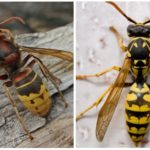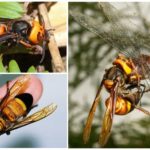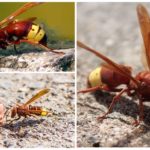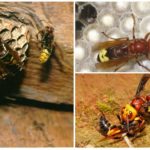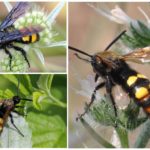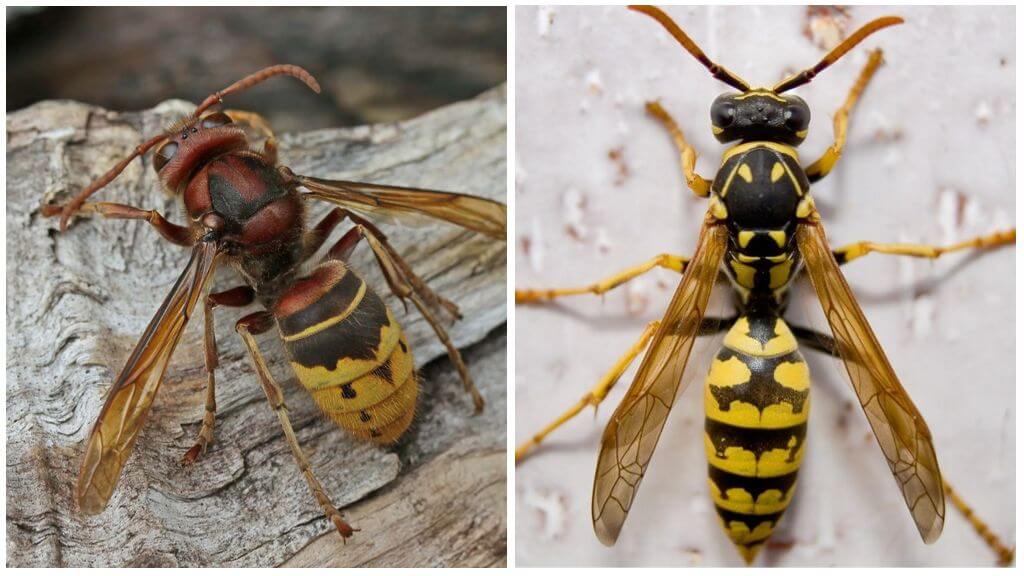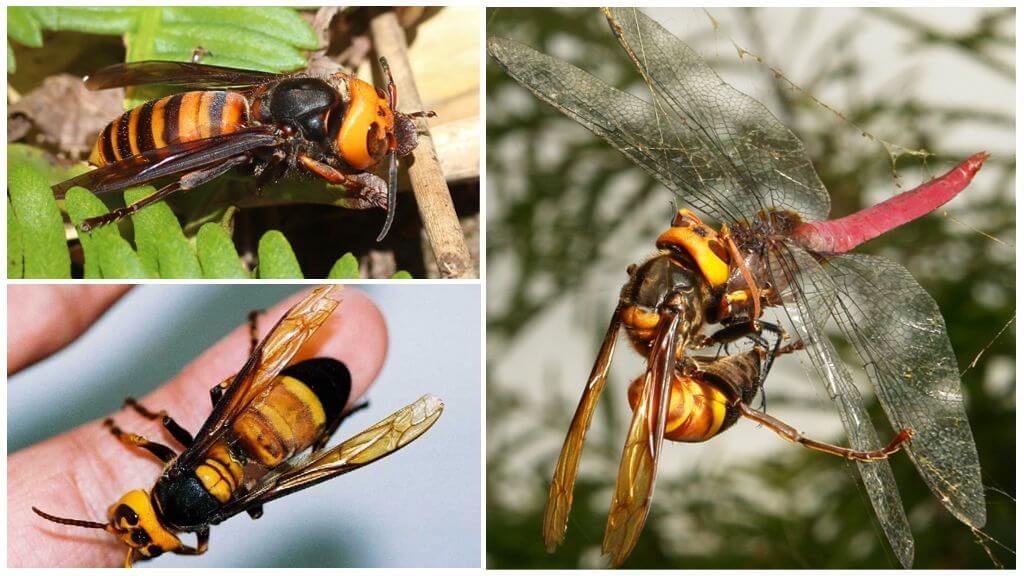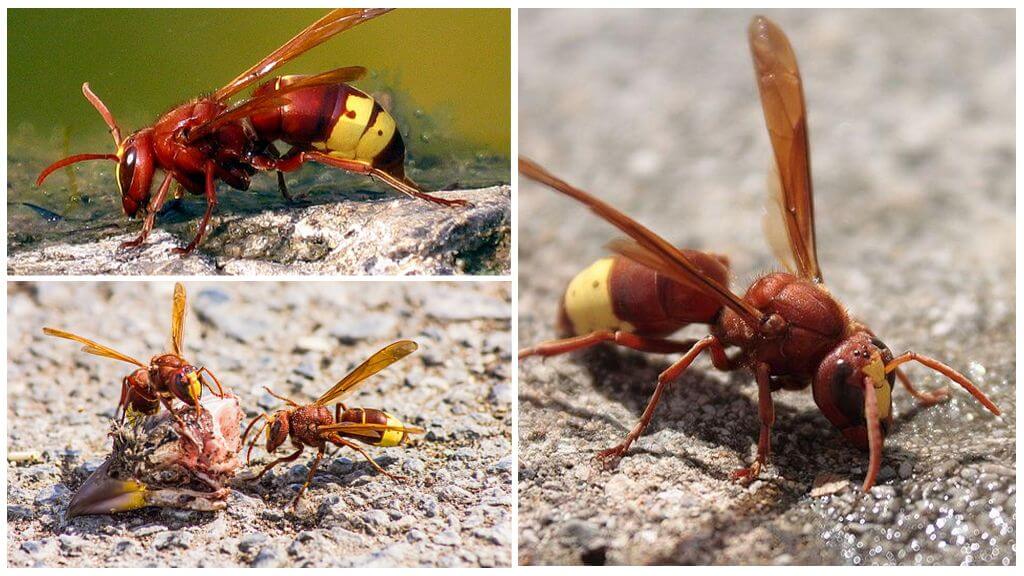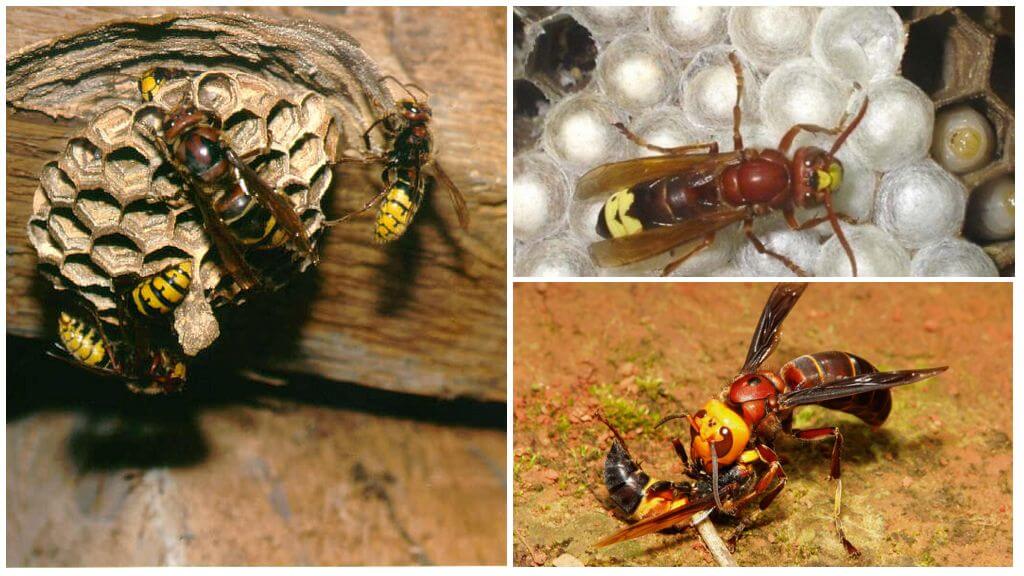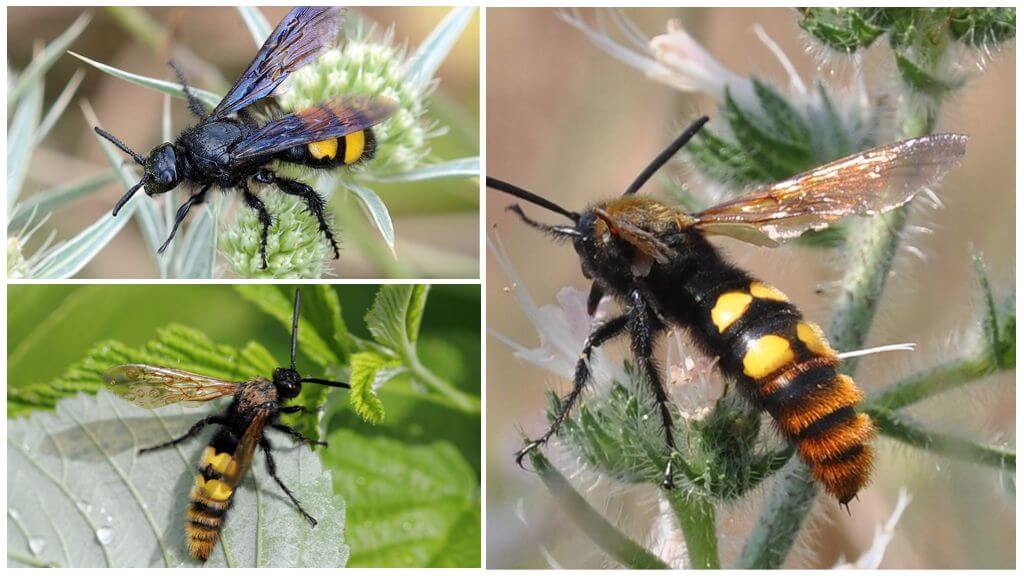Description and photos of hornets
Content
- Hornet and wasp
- Asian giant hornet killer
- Hornet Dybowski
- Eastern Hornet
- Life cycle
- Scolii
Habitats
Hornets are found in the Northern Hemisphere. The real homeland of all these species is Eurasia. Of all the varieties of hornets in North America, only one species has settled - the European. But he was accidentally introduced by settlers and did not progress further than the eastern part of the North American continent.
Interesting!
The same name in America is often called the large spotted wasp.
Since Scoli, wasps and hornets - These are representatives of the same squad, then people often confuse them with each other. It is unlikely that anyone will seriously study the brightly colored insect that has flown through the window. But in some areas these stinging individuals are a protected species, therefore it is useful to be able to distinguish a wasp or a scoli from a hornet.
Comparative characteristics of the European hornet and wasp
Looking at the description and photo of the hornet, it is difficult to immediately understand how it differs from the wasp. Especially if there is nothing to compare. But if you look at a close-up photo of a hornet compared to that of a wasp, the differences become obvious, although the European hornet is very similar to paper wasp.
Common Hornet - the insect of the smallest size from all representatives of this genus. The body length of the European hornet uterus is 2.5-3.5 cm. Working females and males are even smaller: 1.8-2.2 cm. That is, the size of the working individual is almost equal to the size of the wasp, but the torso is much more powerful, and the abdomen sits on completely short jumper, almost touching the chest.
The male differs from the female by a large number of segments on the antennae (13 instead of 12), the number of segments on the abdomen (7 instead of 6) and the absence of a sting. In a dead insect, all this can be counted and checked to make sure that it was not the uterus that was looking for a place to nest.
The head of the hornet is large, round, with a wide nape. The neck of a wasp narrows when moving to the neck. The wings are small and in a calm state are located along the body. The head and chest are brown (black wasps). Abdomen brown below. Yellow and black stripes alternate on top of it.
This species of hornet lives with families that can comprise a significant number of working individuals. Insects are relatively peaceful, if you do not get closer than 0.5 m to the nest, they do not touch. Otherwise they attack together.
Interesting!
Contrary to myths, at the hornet sting only one thing.This is a modified ovipositor that serves to kill prey. Therefore, the reusable tool is smooth and does not get stuck in the skin.
Hornet bite this species is not very dangerous for humans: the bite itch much and swells if combed. In this state, the tissues stay for a week. Then everything passes. The scenario described is true only for people who are not allergic to insect bites.
Feedback
Such people flew into our kitchen, but we thought it was a hefty wasp. The smell of jam flew. Nothing, rolled up newspapers and acted on them. If you slap harder.
Vladimir, Voronezh
On a note!
The species “Ural hornet” does not exist, but the European one is distributed throughout Eurasia, including the Southern Urals. The southern edge of the Ural range almost coincides with the Russian-Kazakh border, in this area there is a high probability of the appearance of another species - the eastern hornet. Therefore, with a high degree of probability, the hornet ordinary (European) or eastern hides under the local name.
But among the types of hornets in Russia there is one truly dangerous for people and livestock. This is an Asian giant hornet killer.
Giant asian
It dwells in warm regions, and a Russian tourist may encounter him when traveling to China, Vietnam, Taiwan or Japan. But as a result of global warming, this species reached the Far East of Russia. This means that you can meet with him without leaving the country.
The size of the hornet reaches 5 cm with a wingspan of up to 7.5 cm. The insect has a very large head. In proportion to the body, it is much larger than that of other members of this genus. Coloring "done" strictly in black and yellow. The photo shows what the Asian hornet looks like. He has a completely yellow head, black chest and a striped belly. Yellow color is very dark and is on the border with orange.
Interesting!
In Japan Asian giant called the "Sparrow Bee". Because of the size of the insect, the poison of this huge wasp much more dangerous. Especially if several bites are applied at once. In Japan, 40 people perish from the sparrow per year.
With the Asian giant are common and black hornets. If the ordinary behaves "decently", then black can and do much harm.
Hornet Dybowski
The second name of this species is “black hornet”. The color resembles a strange bee with a black belly and red-brown head and chest. There are no yellow spots on the body. It is rare, as it leads a parasitic lifestyle. The female Hornet Dybowski seizes the nests of smaller relatives, forcing workers to take care of her offspring. This kind of breeding does not need a "family", enough queens and males.
The bite is stronger than the European species, but weaker than the Asian one. The poison is intended only for the destruction of insects, so the consequences for humans on it may differ from the reaction to the bite of other types of wasps.
On a note!
Another black hornet wasp is a native of China, introduced into France. Vespa velutina is not dangerous for beekeeping and has a completely black color. She has only yellow paws and two thin stripes on the abdomen.
Eastern wasp
A more correct name is the Eastern Hornet. This is the only large wasp insect that can survive in very dry climates. Habitat dry and hot. You can encounter it when traveling to Southern Europe, North Africa, the islands of the Mediterranean, to the semi-arid subtropics of Asia (the former Central Asian republics).In Russia, it is found on the southern borders of the state.
- Medium view. The maximum size of the uterus is 3 cm.
- The color is a bit similar to the European hornet, but the black color is “replaced” with red-brown. The upper third of the abdomen and the tip also have a red-brown color. Between them is a yellow stripe. Because of this brown color, this species of large wasp has the third name: “red hornet”.
The species is very active and causes significant damage to beekeeping farms.
On a note!
The blue hornet does not exist in nature. So mistakenly called purple bumblebee carpenterliving in the southern regions. The bumblebee has a black color, casting purple-blue in the sun. In Russia, found in the Crimea and the Caucasus. The second popular name is the Crimean hornet.
Lifestyle
Almost all species of hornet are social insects. The family structure of the wasps, bumblebees and hornets is the same: the queen, the working females, the males. But hornets build nests not chewed pulp like do it wasps, and collecting building material from birch trees and rotten stumps. Because of the rotten wood, the material for building hornets looks brown, not gray, like ordinary wasps.
The next cycle of life of hornets begins with the exit of the uterus from hibernation. She flies around in search of a suitable nesting site. Having found a suitable place, the queen of hornets makes the first honeycomb and lays eggs in them. From her point of view, suitable places are:
- tree hollows;
- attics;
- woody branches in the tropics.
Sometimes the place where the hornets live is very unexpected for a person: a nest can be built in a crack under a concrete staircase or between window frames.
After the appearance of the first imago, she dumps all the work on the nest rebuilding and feeding of the larvae on the working females, and ceases to leave the dwelling itself.
Depending on the degree of development of food types change, what do hornets eat. Adults prefer foods that are rich in easily digestible carbohydrates. They can often be found on fruit trees, where they gnaw holes in ripe fruit. Willingly fly to the smell of jam. When attacking a beehive, hornets destroy not only bees and their larvae, but also eat honey. Asian giants in Japan are notable for their “terrorism” in relation to honey bees.
But these individuals are both harmful and beneficial. These large wasps catch various insects for a reason. Hornet larvae feed on protein mass, which is consumed as a suspension. Adults to feed their offspring, crushed captured pests to a semi-liquid state. Food needs a lot, and working females hunt all day. In nature, hornets are needed to control the numbers of other insects, although giant wasps do not make a distinction between the caterpillar of the white moth and the larva of a domestic honey bee. But the hornets themselves have almost no natural enemies, except man.
On a note!
It eats hornets only golden bee-eater, she is a bee-eater.
In the warm season, the hornet family thrives and grows in size. But the term, how many hornets live, directly depends on their life purpose:
- males until the fertilization of the female;
- working females before the onset of cold weather;
- queen more than a year.
Honey hornets do not stock up, like their younger sisters. This is due to the fact that hornets hibernate and wasps in the same way: only the fertilized queens "leave" for the winter.
On a note!
Continuers of the genus: queens and males-producers appear in the family in late August - early September.
At the same time, the young queens are fertilized.Since the uterus is already “charged”, the hornets multiply from the moment the queen came out of hibernation and built the first cells of the cells. The first egg laying means a new life cycle.
Also dangerous
There is another family of insects, similar to the hornet, but belonging to another family of hymenoptera. This is scoli. In size, they are not inferior to hornet. The giant colia that lives in Europe and the southern regions of Russia up to the Voronezh region reaches a length of 5 cm with a wingspan of 10 cm.
Important!
Scolies are harmless if they are not caught. Otherwise they can sting.
But these insects bring exclusively benefit: adult insects pollinate plants, larvae - ectoparasites of garden pests. As food for them are the larvae of the May beetles, weevils, rhinoceros beetles.
The color scheme of the giant scolium is similar to the color of the European hornet: black and yellow stripes on the abdomen and black and yellow head. But the location and width of the bands is different.

